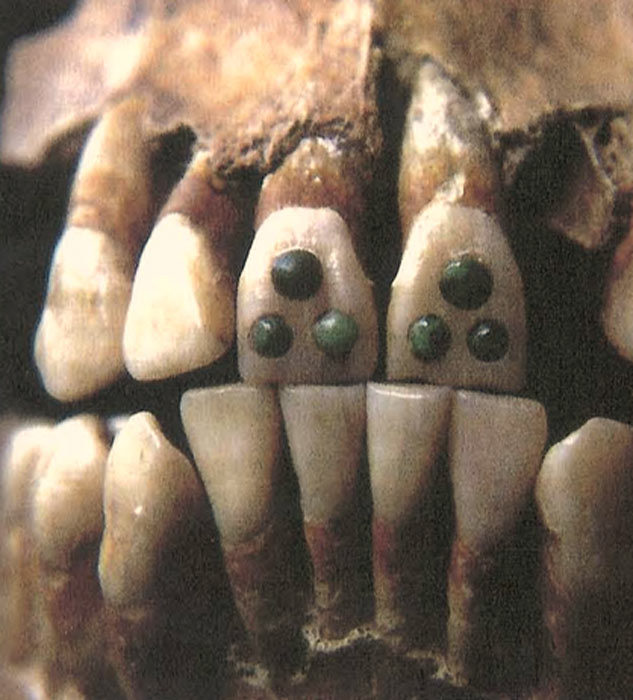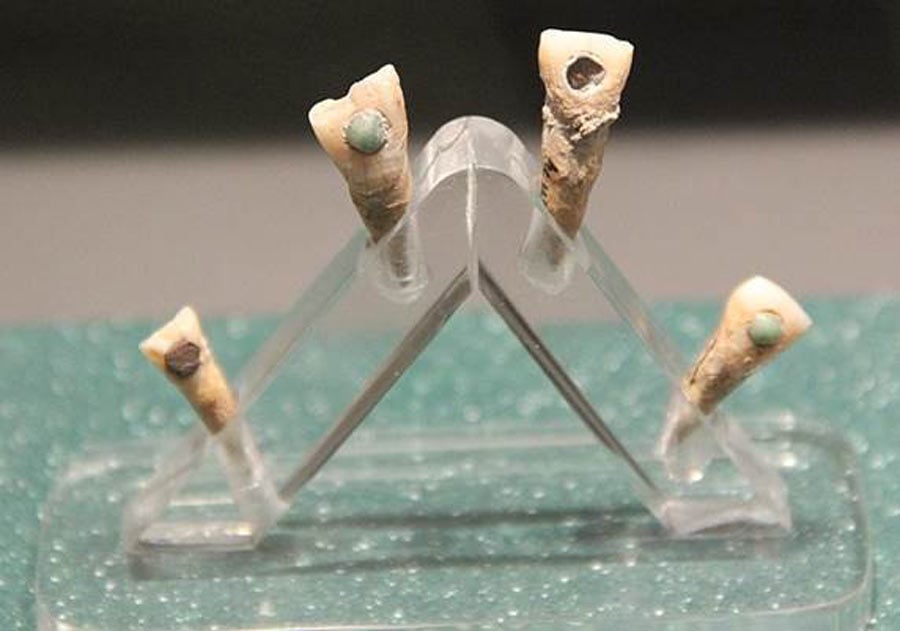Ancient Maya Tooth Bling Was Also Good for Oral Hygiene!
The Maya loved their bling and often decorated their teeth with gemstones. But maybe these weren’t all just for show. A new study conducted by the Center for Research and Advanced Studies of the National Polytechnic Institute in Mexico City, has revealed that the glues used to bind precious stones to Maya teeth might have had antibacterial properties, boosting their oral health.
When England published the London Bills of Mortality in the early 16th century listing the main causes of death, “teeth,” were listed in the top five. However, the new Maya teeth study shows that if a similar census had been taken in Mexico at the same time “teeth” wouldn't even have been on the list!

An example of a Maya teeth featuring a gemstone in inlay modification. (Emmashavrick / CC BY-SA 4.0)
Maya Teeth and Tooth Modification Wasn’t Just Ritualistic!
Emerging around 1000 BC, the Maya civilization quickly developed and reached its highest point between 300 and 900 AD. Dominating south-east Mexico and the Central American countries of Guatemala, Belize, Honduras and El Salvador, hundreds of independent farming states managed vast ceremonial cities. The Maya are renowned for constructing elaborate ceremonial palaces, temple-pyramids and astronomical observatories, but also for decorating their teeth with colorful rocks.
- Jewel-Capped Teeth and Golden Bridges: 14,000 Years of Dentistry
- 130,000-Year-Old Neanderthal Teeth Reveal Evidence of Prehistoric Dentistry
It has long been assumed that Maya tooth modification was only carried out for ritual purposes, however, the new study published in the Journal of Archaeological Science suggests Maya dental techniques also benefited general oral hygiene.

The recent study on Maya teeth revealed how plant sealants, mostly made from pine trees, were also part of the teeth jewelry procedures performed by Maya dentists. (Journal of Archaeological Science)
Breathing The Word of God
The team wrote that ancient Maya “believed their breath was a link to the divine.” Therefore, to ritualistically purify the mouth, Maya teeth were polished, bored, and notched. And in some cases, front teeth were encrusted with gemstones including “jadeite, iron pyrites, hematite, turquoise, quartz, serpentine and cinnabar,” said Dr. Gloria Hernández Bolio, a biochemist at the Center for Research and Advanced Studies of the National Polytechnic Institute in Mexico. In the new study the professor and her colleagues analyzed sealants taken from eight teeth samples from different sites across the Maya empire.
First, based on light absorption, the scientists grouped the organic compounds, then, they separated chemical mixtures using intense heat and counted the individual molecules. The study research identified 150 organic plant resin molecules, mostly from pine trees, that together acted like a glue. And the scientists categorized four individual mixtures based on the locations they were prepared. It is known that pine resin attacks the bacteria that causes plaque and eventual decay on teeth. However, two glue samples contained sclareolide from Salvia plants. In the modern world sclareolide is used to bind perfumes to the skin, and more recently has been used as a weight loss drug. However, in Maya culture, it seems, this substance was valued for its antibacterial and antifungal properties.

Maya dentists spun thin copper tubes in their hands which served as drills, with the abrasive quality coming from powdered quartz mixed in water. (YouTube screenshot / Nutty History)
Marrying Aesthetics With Health Care
Study co-author, Vera Tiesler, a bioarchaeologist at the Autonomous University of Yucatán said Maya dentists drilled holes into the enamel and dentine “then fit the stones and applied a sealant, usually as part of a rite of passage to adulthood.” The new analysis, according to Tiesler, suggests the sealant applied to secure the tooth jewels in place also had therapeutic oral hygiene properties. Tiesler references Janaab’ Pakal, the Maya king of Palenque, who died in 612 AD at the age of 80. Not only did he die with nearly all his teeth, but there were “no signs of decay.”
- Waterloo Teeth: Wearing A Dead Man’s Grin
- 13,000-Year-Old Bitumen Dental Fillings Found in Italy: Earliest Example of Dentistry Known to Date
Maya dentists spun thin copper tubes in their hands which served as drills, with the abrasive quality coming from powdered quartz mixed in water. After they had bored holes into tooth enamel the final stones to be inlaid were finely-shaped to fit the cavities. At this stage the dentists applied an adhesive to hold the stones in place. Earlier studies found inorganic cement-like materials within the mixtures, but the chemical makeup of the tooth binding agents had long evaded scientists.
Cristina Verdugo, an anthropologist from the University of California, Santa Cruz, says this new study “finally addresses the long-standing question of how these stones were affixed.” Furthermore, besides knowing the secrets of shaping and boring teeth the study suggests Maya dentists also knew the secrets of avoiding postoperative infections.
Top image: Maya teeth were turned into jeweled teeth by skilled ancient dentists, but a recent study suggests that this also benefited oral hygiene! Source: Gary Todd / CC0
By Ashley Cowie



















